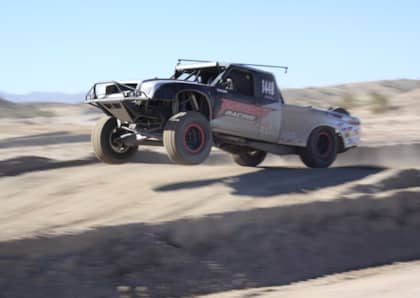Ride like Royalty: 2015 Toyota 4Runner King Suspension Upgrade
In the world of off-road capable SUVs, the Toyota 4Runner has quite the legacy. While the evolution of the 4Runner has it far removed from the simplistic and rugged solid axle first generation models, the midsized SUV hasn’t forgotten its roots. As one of the few body-on-frame SUVs still offered in North America, the fifth-generation 4Runner sports a solid rear axle and independent front suspension that it shares with the Toyota Tacoma. Aside from the Jeep Wrangler Unlimited, there are few more affordable and capable mid-sized SUVs on the market.
Maybe the only thing the 4Runner is lacking out of the box is a dynamic suspension system. Sure, you could opt for the TRD Pro if you were looking to buy new. But, that’s going to set you back a cool 6,000 dollars more than a base SR5. You can buy a lot of upgrades for that kind of coin. For our 2015 Toyota 4Runner, we enjoy the comforts of the daily driven SUV, but have always felt the stock suspension falls a little short. This is partly due to the IFS/solid axle rear configuration that reacts very differently to absorbing obstacles.
Couple this with slightly undervalued factory shocks and you have the recipe for a bucking SUV in the dirt and an extra bouncy one on the road. The fix? For us it was as simple as replacing the front and rear shocks. Since we were happy with the ride height of the 4Runner, but not the ride quality, we wanted something that would improve the suspension performance, without creating the complications sometimes associated with lifting the vehicle. With an assortment of options available from the aftermarket, we chose King’s OEM Performance Series for the value, quality track record and bolt-on system built specifically for the fifth generation 4Runner.
While you watch the crew at Low Range 4x4 knock out our install in the video above, we’re diving more into the details of the suspension in the article below.

Changing the Ride
Up front, King replaces the stock coil-over-strut, with a 2.5-inch remote reservoir coilover. These come fully assembled and paired with a 14-inch, 550 pound coil spring. Heavier spring rates are offered for those running aftermarket accessories such as a winch bumper or additional body armor.

Adjusting the shock’s valving to match your driving style and vehicle needs used to require tearing down the shock and replacing the valve packs inside. These days, King has made it much easier by offering optional compression adjuster knobs on its remote-reservoir shocks. These knobs offer 16 levels of compression (upwards shock travel) adjustment. These range from soft (smooth street driving) to very firm (off-road desert assassin).

The 4Runner-specific system is engineered as a completely bolt-on upgrade. No drilling or cutting is required. There are even reservoir mounts that attach via the sway bar mounting points, which tuck them neatly out of the way.

Speaking of sway bars, the reservoir mounts move the bar slightly forward and down. To ensure that it doesn’t contact the skidplate braces upfront, King provides drop spacers and longer hardware to prevent the components from making contact.

Out back, King provides 2.5-inch smooth-body remote-reservoir shocks. These lightweight units are fit with hard anodized 6063 aluminum alloy fluid reservoirs and hardened chrome shafts. This allows the nitrogen-charged absorber to be corrosion resistant and dissipate heat quickly to reduce shock fatigue.

As is the case with the front, the rear shocks mount in the stock location. The reservoir mount ties into the stock bumpstop mounting location to keep the cylinder out of harm’s way. These shocks are designed to work with coil springs up to two inches over stock. We’re keeping our factory coils in for now as the lighter factory coil rate combined with the more aggressive King valving is an excellent recipe for a smooth ride.

Boots on the Ground
Another critical equation to increase the performance of the 4Runner was fitting it with a better set of treads. We opted to go with Nitto Ridge Grapplers in a 265/70R17. This is the recommended stock sizing for the 4Runner, which meant we could easily have a fullsize spare onboard and didn’t have to worry about rubbing issues since we were retaining the stock 4Runner wheels.

Seat Time
Since we had our coilovers set with the pre-load adjuster at its highest setting, we only gained roughly 1-inch of lift. This took the 4Runner closer to level, which was a welcomed change. Out of the gate, we immediately noticed how much smoother the 4Runner rode. The large shocks combined with the increased valving properties made a huge difference with how the 4Runner handled. On-road, this equates to a speed bump slayer that’s more stable in the corners and laughs up imperfections in the road. Off-road, it means you won’t bounce all over the dirt when the trail gets rough. The faster you want to push the vehicle, the higher you’ll want to dial up the adjuster knobs. We found the lightest setting to work best on-road for the front coilovers, with a few clicks to the firmer position out back. Much of this will depend on ride preferences and optional equipment.

Overall, it’s pretty impressive at how quickly a better suspension system and tire can alter the 4Runner in such a positive way. We’re continuing to roll on the miles on our Ridge Grapplers and are amazed at how quiet they are, despite the more aggressive tread design. We’ll have long-term updates on our 4Runner build, so be sure to check back for the latest updates.











